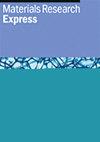Croton macrostachyus leaf-mediated biosynthesis of copper oxide nanoparticles for enhanced catalytic reduction of organic dyes
IF 2.2
4区 材料科学
Q3 MATERIALS SCIENCE, MULTIDISCIPLINARY
引用次数: 0
Abstract
Introduction. Owing to the increasing use of organic dyes, the biosynthesis of metal oxide nanocatalysts is urgently needed as an economical and environmentally friendly solution to reduce their waste release. Method. In this study, we synthesized copper oxide nanoparticles (CuO NPs) by the sol–gel method using Croton macrostachyus leaf extracts as capping and reducing agents. The biosynthesized CuO catalysts were characterized using x-ray diffraction analysis (XRD), thermogravimetric differential thermal analysis (TGA-DTA), scanning electron microscopy (SEM), energy dispersive spectroscopy (EDS), and Fourier transform infrared spectroscopy (FTIR). Result. The result showed that the synthesized CuO NPs had a crystallite size of about 9 nm and had good crystalline texture. Furthermore, the catalyst showed the best catalytic reduction performance in 1 min for methylene blue (MB) and 3 min for methyl orange (MO). Furthermore, the CuO catalyst synthesized using Croton macrostachyus leaf extract resulted in apparent rate constant (Kapp) values for MB and MO of 0.06793 s−1 and 0.01877 s−1, respectively. Discussion. The recyclability of the CuO catalyst was investigated, and it was shown that the catalysts are suitable for reuse in dye reduction. Therefore, the catalytic activity of this study suggests that the CuO nanocatalysts prepared in this work are a potential candidate for controlling organic pollutants or trace amounts of naturally occurring active organic chemicals in all environmental dye wastes.巴豆叶介导的纳米氧化铜生物合成用于增强有机染料的催化还原作用
导言。由于有机染料的使用量不断增加,迫切需要生物合成金属氧化物纳米催化剂作为一种经济环保的解决方案,以减少有机染料的废物排放。研究方法本研究以巴豆叶提取物为封端剂和还原剂,采用溶胶-凝胶法合成了氧化铜纳米颗粒(CuO NPs)。使用 X 射线衍射分析 (XRD)、热重差热分析 (TGA-DTA)、扫描电子显微镜 (SEM)、能量色散光谱 (EDS) 和傅立叶变换红外光谱 (FTIR) 对生物合成的 CuO 催化剂进行了表征。结果结果表明,合成的 CuO NPs 结晶粒度约为 9 nm,具有良好的结晶质地。此外,催化剂在 1 分钟内对亚甲蓝(MB)和 3 分钟内对甲基橙(MO)的催化还原性能最佳。此外,使用巴豆叶提取物合成的 CuO 催化剂对 MB 和 MO 的表观速率常数 (Kapp) 值分别为 0.06793 s-1 和 0.01877 s-1。讨论对 CuO 催化剂的可回收性进行了研究,结果表明催化剂适合在染料还原中重复使用。因此,本研究的催化活性表明,本研究制备的 CuO 纳米催化剂是控制所有环境染料废料中有机污染物或痕量天然活性有机化学物质的潜在候选材料。
本文章由计算机程序翻译,如有差异,请以英文原文为准。
求助全文
约1分钟内获得全文
求助全文
来源期刊

Materials Research Express
MATERIALS SCIENCE, MULTIDISCIPLINARY-
CiteScore
4.50
自引率
4.30%
发文量
640
审稿时长
12 weeks
期刊介绍:
A broad, rapid peer-review journal publishing new experimental and theoretical research on the design, fabrication, properties and applications of all classes of materials.
 求助内容:
求助内容: 应助结果提醒方式:
应助结果提醒方式:


